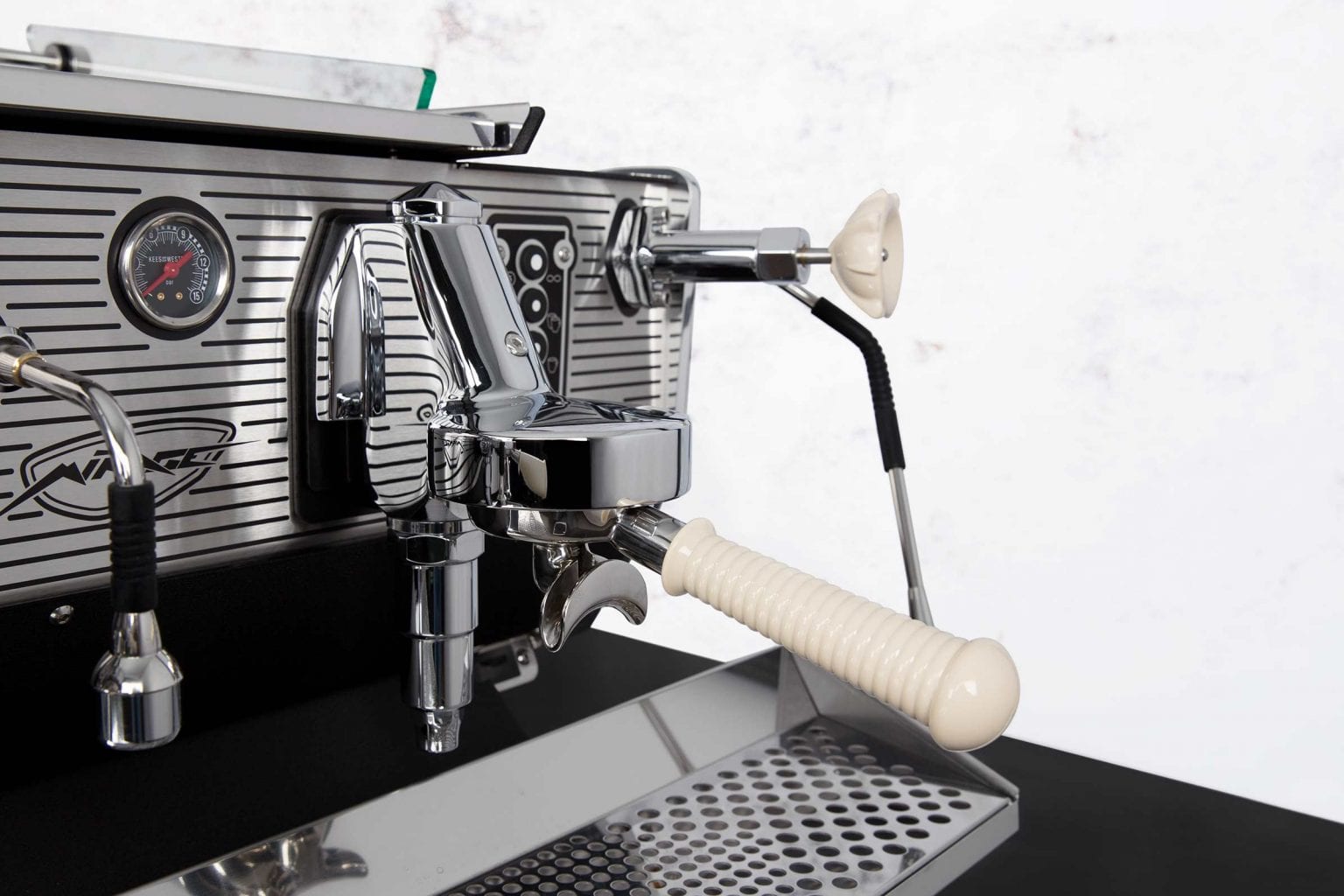
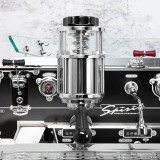
FREE SHIPPING ON ORDERS $99+ IN THE CONTINENTAL USA (EXCLUSIONS APPLY)
We only carry the best.
We know our products.
We are here for you.
Free shipping on most retail orders $99+

The Mirage's heating system is based on the so-called thermo-syphon system. It consists of one large copper boiler (13ltr for the Duette, 19ltr for the Triplette), equipped with a heat-exchanger for each group, running vertically slanted across the boiler.
This HX is connected to the rear of the group by a thick tube running from top of HX to group and another tube running from rear of group to bottom of HX, completing a vertical circuit.
THERMO-SYPHON LOOP AT WORK
SYSTEM AT IDLE
The group sitting at the very end of the thermo-syphon loop is a vitally important stabilizing factor. It is after all the last part water travels through before hitting the coffee, during brewing. Its temperature therefore is important and should be very close to the desired temperature of the brewing water.
The temperature of the group body can be adjusted simply by having more or less hot water flow through its rear chamber. The temperature inside the HX being quite a bit higher than the desired temperature for the group, the thermo-syphon loop needs to slow down, needs to be restricted.
With the Mirage we adjust the boiler to 125 degrees Celsius. To get the group body temperature at low nineties we install a standard restrictor at the top of the HX with a passage of 1.5mm.
With different restrictors installed it is quite possible to operate one machine with temperatures adjusted differently from group to group, for example to accommodate for the use of lighter and darker roasted coffees. As an option we offer adjustable restrictors.
One also may attempt to change the group temperature by changing the boiler temperature, but this method is limited because fairly large boiler temperature changes are needed to realize just a little effect at the group. Also the steam or hot water capacity of the boiler may be affected that way. With the proper restrictor one can for example easily combine the extremes of 1.5 bar high steam power with a low 88 degrees C. brew temperature.
The challenge of the thermo-syphon system is to get water of low nineties temperature to the coffee, provided by a HX that stores water at 125 degrees. The extra heat is needed to keep the group at its perfect temperature, the remaining heat is needed to deliver brewing water of the correct temperature. To start the brew process the group solenoid valve opens the path from the thermo-syphon system towards the coffee in the filter holder. At the same moment the pump starts to run, keeping the pressure at a steady 9 bar, everywhere between pump and coffee.
The sudden exit, provided by the open solenoid valve, has a drastic result. All water will now flow to that exit, pushed out by the pump pressure. The flow in the lower tube changes direction, it flows upwards to the group, instead of downwards to the bottom of the HX. The flow in the upper tube remains the same.
The crucially important second function of the restrictor now becomes clear. The flow through the upper tube towards the group is severely restricted by the1.5mm orifice of the restrictor. The lower tube does not have any restriction, it has an inside diameter of 8mm. This full-flow 8mm, compared to the 1.5mm, means 99% of the water reaching the group arrives via the lower tube.
This suits the requirements very well, since this lower tube contains the cooler water (generally 88-92 degrees, compared to the upper tube 115-125 degrees). To get the most out of this, we install a very long lower tube in the Mirage, containing 30cc. The remaining water comes directly from the HX. All water leaving the HX is replaced simultaneously by fresh cold water. The hot water leaves the HX through the lower tube, from bottom of HX. The cold water enters the HX also through the bottom.
The cross flow of outgoing hot and incoming cold water is used to help each other. As there is just a 1mm copper wall between these 2 flows, the outgoing hot water is cooled down considerably, losing its heat to the incoming cold which starts to heat up right away. The cold water is forced to travel to the top of the HX via a long injection tube.
When leaving the top of the injection tube it needs to travel down again to the bottom of the HX, during brewing. This ensures the heating capability of the HX is used to its full capacity. Naturally, the cooling down of the water from HX to lower tube by the crossflow is not a very precise process, as the temperature of the cold water can vary because of climate, location, season, etc. It will however be a major drop to well below 100 C. Travelling upwards through the long lower tube offers a good start to further stabilise. When entering the big brass group body the temperature of the water will be easily stabilized to the correct temperature of the group.
To facilitate this temperature stabilization process we changed the insides of the group to increase the contact of water with the group body as much as possible. During brewing the water first passes the 35cc chamber in the rear of the group, then runs to the solenoid valve from where it re-enters the group. It fills the infusion chamber, passes through the passages towards dispersion fitting and finally is pressed through the group membrane- type screen.
The stabilizing ability of the mass of 4kg brass is impressive. Even after taking a bucket of hot water from the main boiler, causing this to cool down for a short while during re-filling with cold water, the energy stored within the brass ensures enough shots of the correct temperature to allow the boiler to regain its standard temperature. When starting a shot, we recommend to draw a short flush: 30-45cc. Never flush more, because the water runs much faster through the entire system during a flush. When flushing longer the inherent stability of the system can easily be ruined, requiring at least 5 minutes to completely restore.
CONCLUSION
55 Years after its creation the E61 thermo-syphon system can still very much be considered a technically highly elegant system. Especially the thermal efficiency impresses and easily surpasses the popular multi-boiler systems. In comparison, the double, or multi boiler system, can technically be regarded as rather run of the mill.
It is a great pity the Italian espresso machine industry, although widely adopting the thermo-syphon idea, did for about 40 years not take any initiative to keep on developing. Instead, it finally took the easy way, went back in time and grabbed the previous old idea of separate boilers for steam and coffee production. As a tiny company we could only follow. We do our best to offer the finest of either system.
Shift efficiency and ergonomics up a gear, and put your foot down to steam. The KVDW foot-pedal is safe, fast, leaves your hands free and feels like the most natural way to work. Once you try it you never want to go back!

Also retrofittable to Mirages built since May 2015.
Each group can be activated with 4 easily programmed volumetric buttons, or a continuous flow button.

Each group is activated by one of our custom “Bastones”, a small lever which offers two programmable volumetric settings and, via a pushbutton, a continuous flow. The Bastone can also be programmed for full manual control.
All our machines are made from high grade stainless steel. The body panels can be engine turned to stand out in any environment.

The stainless steel body panels are finished with a crackle black powder coating. This durable finish creates a striking contrast between the bodywork and the polished parts.
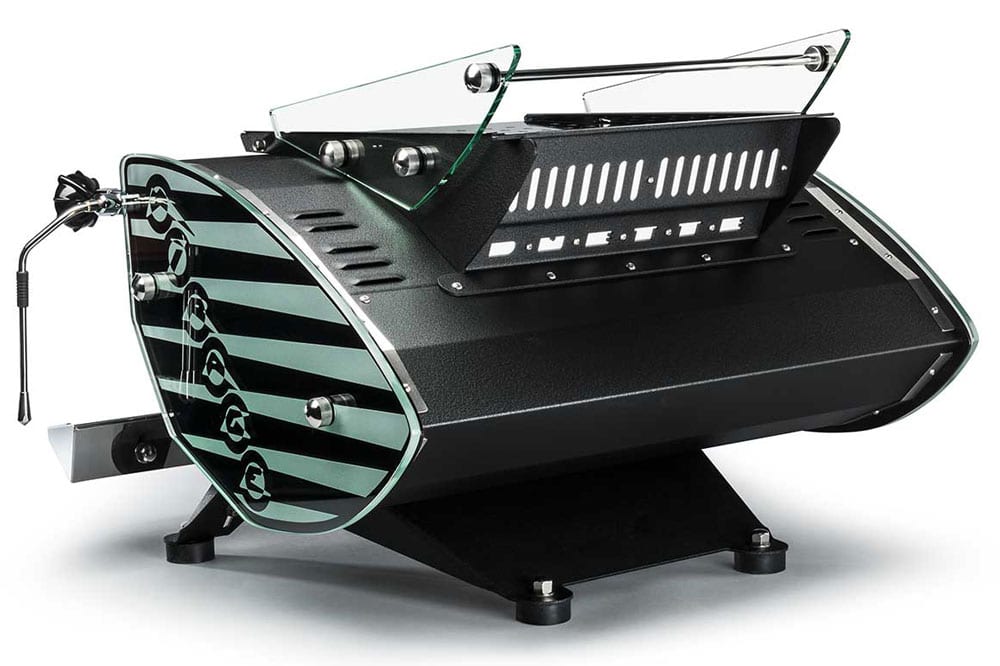
The updated Mirage design is sandblasted in 10mm thick glass side panels.
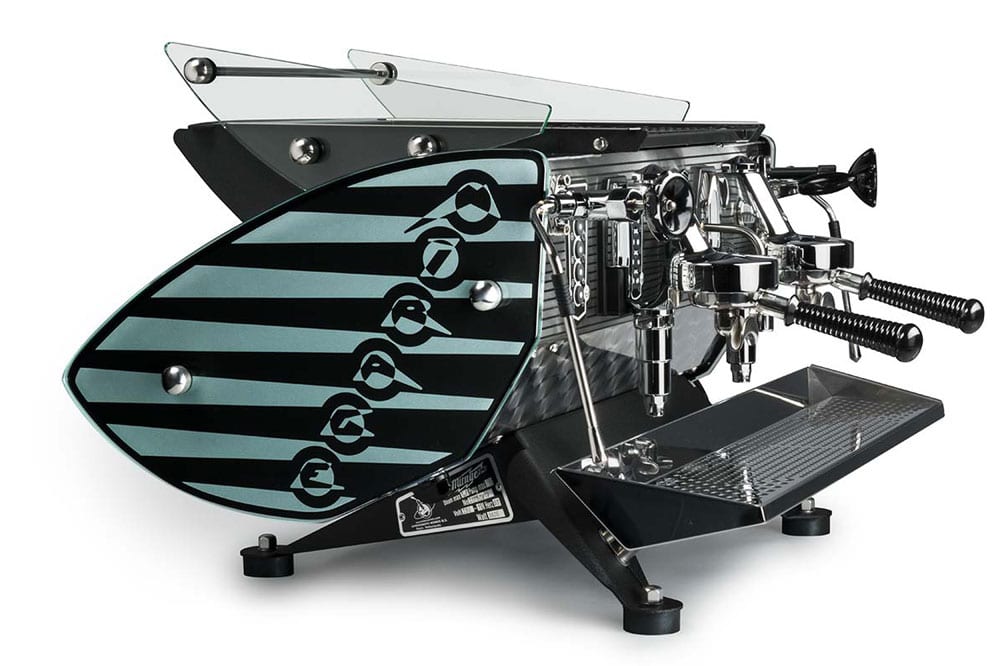
Personalize your machine with your own logo or custom design. This can be sandblasted – suitable for monochrome logo’s and text, or printed – suitable for full colour designs and images.
Click here to download the specification file.

Milled and polished aircraft- grade aluminum side panels make your Mirage stand out in any environment.
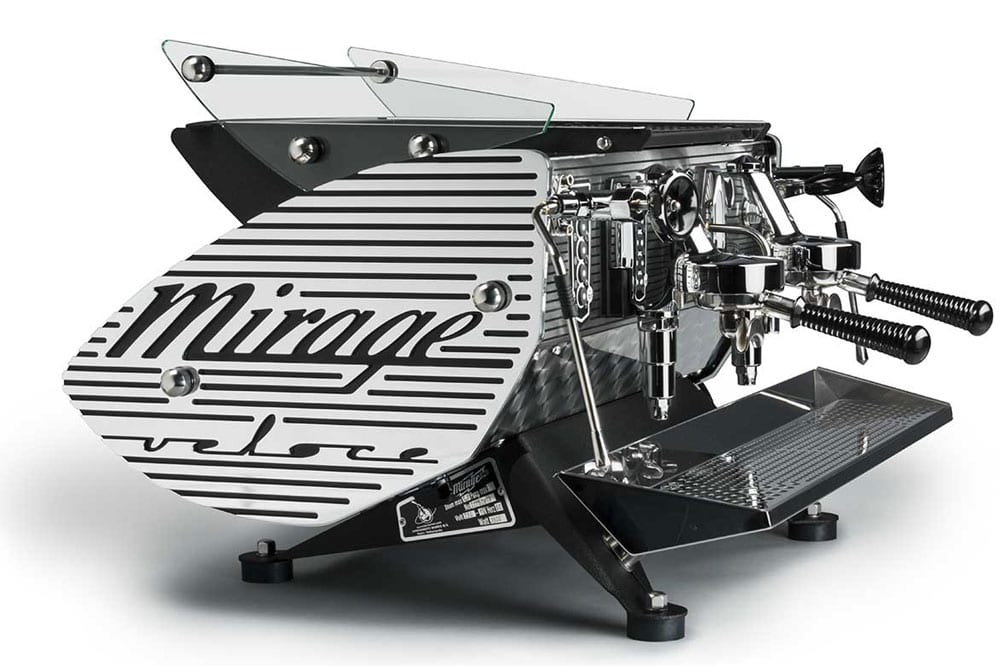
Adapt your drip tray for espresso cups quickly and easily. This option brings cup and machine closer together.
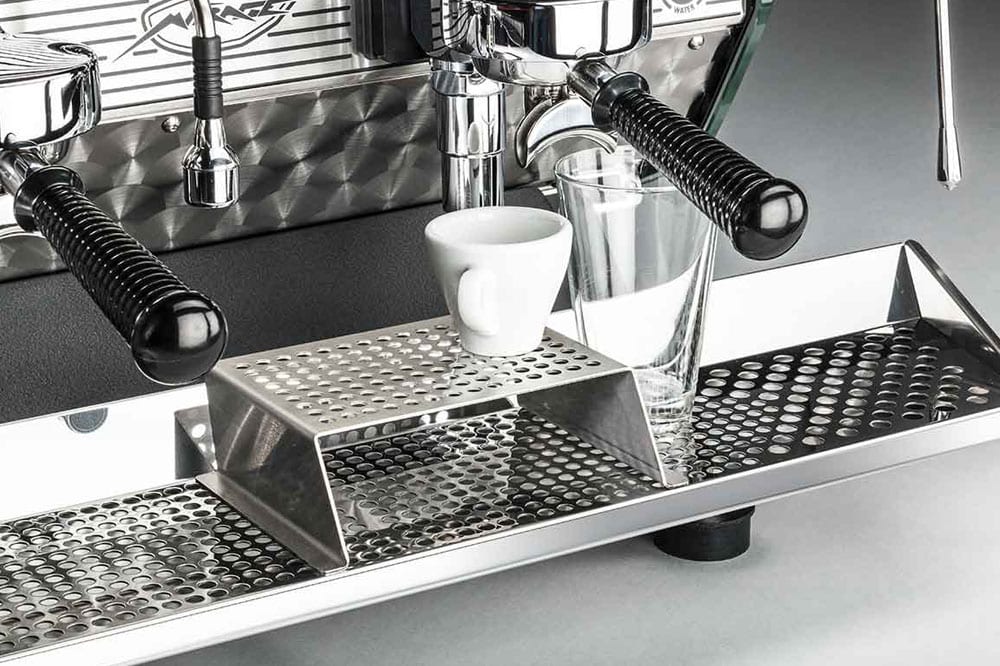
Extra room for your milk pitcher before, during and after steaming. Easily adjustable in height and can be mounted on the left or right of the drip tray.
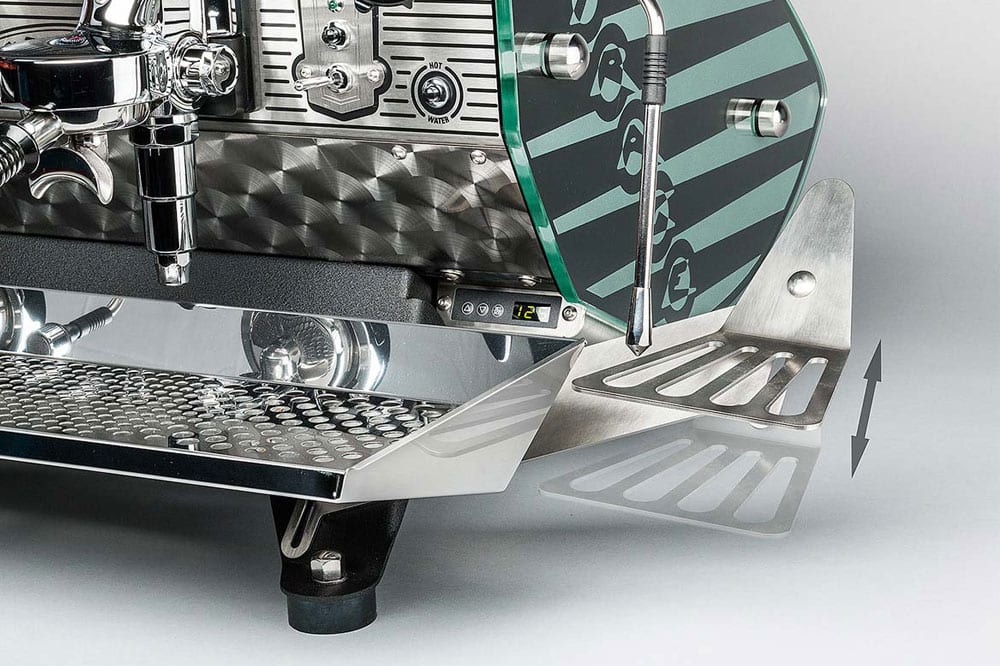
Double the size of the cup tray on top of your machine. (Note – these parts are not directly heated).
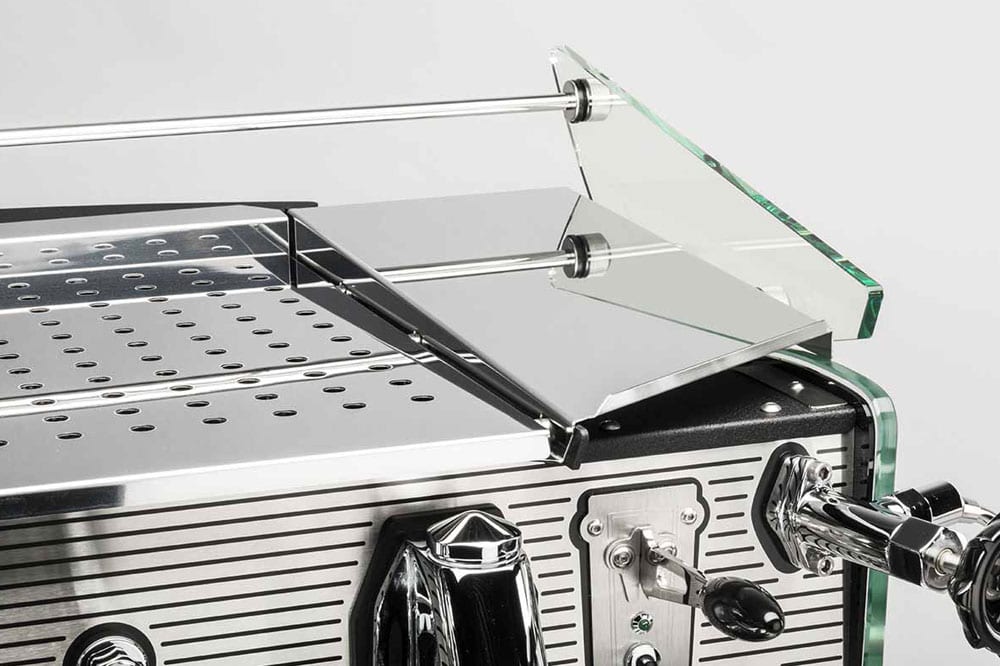
Lever activated steam valve, also retrofittable to older Mirages.
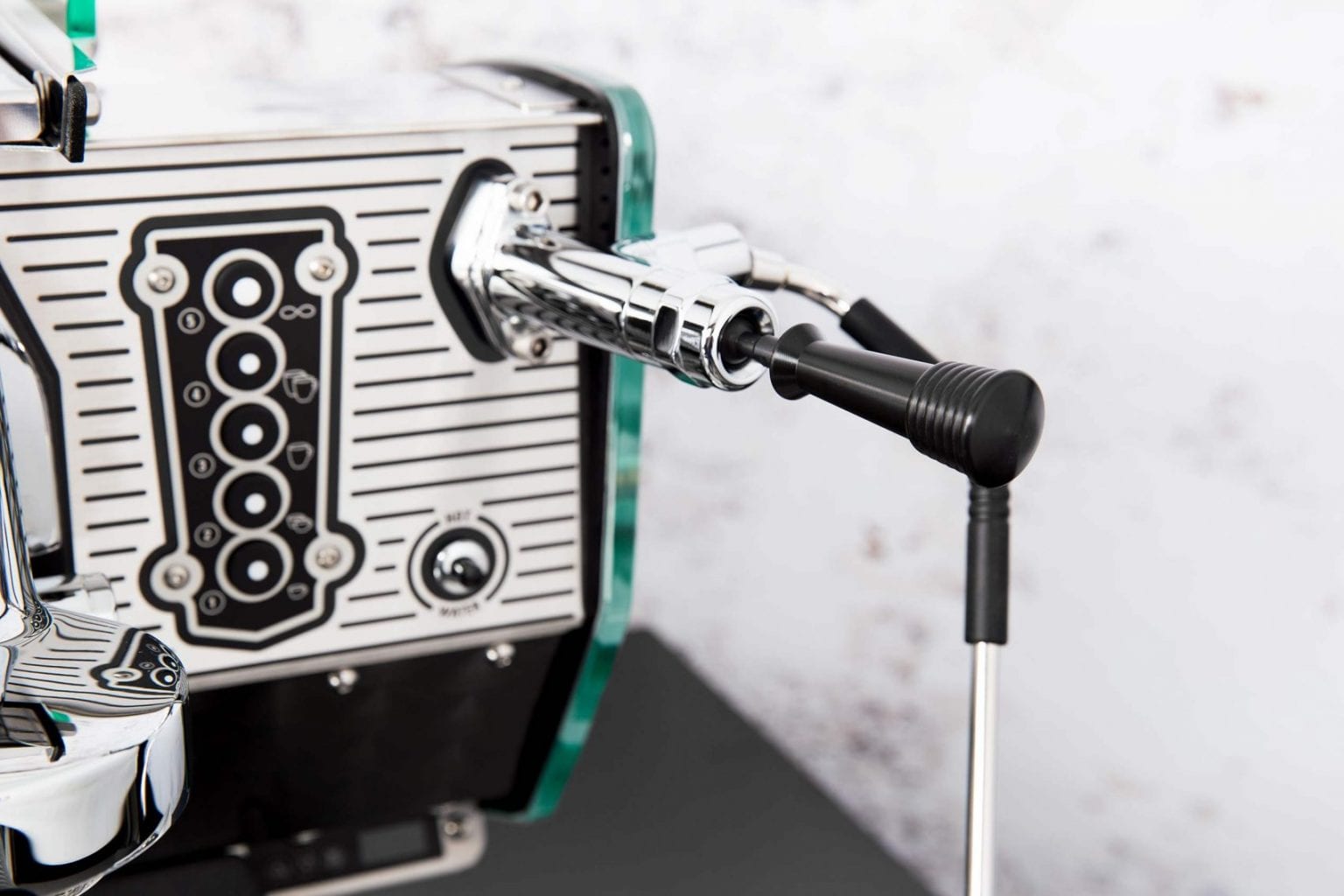
Steam valve knobs & filter holder handles made of ivory coloured material.
